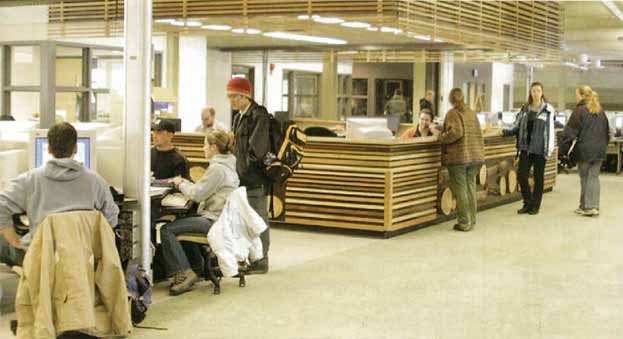Awards
Robbie Sane Architects



By Barbara Carss
-- Continuation from Page 3 --
Building Incentive Program (CBIP), a federal program providing design subsidies for proponents who develop buildings that are at least 25% more energy efficient than the MNECB standards.
The environmental technology wing is ranked seventh among more than 400 buildings registered with CBIP since 1998. "When you're in the 60% range, you're talking about a very energy efficient building. We only have a handful of buildings that are at that level", says Pierre Guevremont, Chief of the New Buildings Program in NRCan's Office of Energy Efficiency.
ENROLLMENT GROWTH SPINOFF
Recent significant capital investment in Ontario's post-secondary education sector has dovetailed nicely with CBIP objectives. The provincial government has dispersed hundreds of millions of dollars to universities and colleges since the beginning of the decade in preparation for a projected dramatic influx of students.
"The largest group of buildings we have is educational facilities and a lot of those, I think, were due to the expansion in Ontario", Guevremont says.
"What we see is that the institutional clients can perhaps have a slightly longer payback for their projects." CBIP's most energy efficient result to date is a building at the University of Ottawa that is considered 73% more efficient than MNECB standards.
In addition to the Frost Campus in Lindsay, Fleming College has three other sites in Peterborough, Cobourg and Haliburton -- variously located about one to two hours drive north-east of Toronto -- and received $27.5 million in Ontario SuperBuild infrastructure funds to make room for an additional 3,000 students. Many of these spaces will be at the Frost Campus where the current enrollment of 1,500 to 1,700 students is expected to rise to 2,500 students during the next 10 years.
Although the Frost Campus's original focus on natural resource sectors such as forestry and fisheries remains strong, the new wing accommodates a steadily expanding emphasis on the many aspects of environmental science and management. This includes a new Bachelor of Applied Technology in Environmental Assessment and Management program, which will be launched in September 2005.
EXTENDED CLASSROOM
Conceptually, the new wing pays heed to its own natural setting and its place in a wider environmental context. The north-south and east-west discovery trails are the main interior thoroughfares offering passerby clear sight lines to researchers at work in the labs and greenhouse as well as a panoply of flora, fauna and geological specimens.
Impressions of native Ontario plants and animal tracks are embeded in the floor along with limestone and granite outcroppings to symbolize the bedrock below. A plexiglas cover provides a view down into the workings of the wing's geothermal, ground source heating system.
The walks boast colourful maps and posters illustrating natural life from regions across the province, while a series if 100-gallon aquariums will hold the fish species of Ontario. Lattice work on the ceiling represents Ontario's major tree species and taxidermy is suspended in the labs.
"People can just look up and see a lake trout or a black bear," reports Lee Gutowsky, a third year student in Ecosystems Management who is president of the Frost Campus students' association. "I volunteer with the Scouts in Lindsay and I'm looking forward to bringing them to the new wing."
CANADIAN PROPERTY MANAGEMENT, NOVEMBER 2004